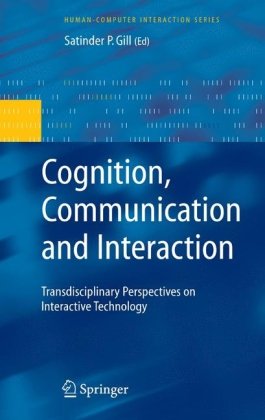

Most ebook files are in PDF format, so you can easily read them using various software such as Foxit Reader or directly on the Google Chrome browser.
Some ebook files are released by publishers in other formats such as .awz, .mobi, .epub, .fb2, etc. You may need to install specific software to read these formats on mobile/PC, such as Calibre.
Please read the tutorial at this link: https://ebookbell.com/faq
We offer FREE conversion to the popular formats you request; however, this may take some time. Therefore, right after payment, please email us, and we will try to provide the service as quickly as possible.
For some exceptional file formats or broken links (if any), please refrain from opening any disputes. Instead, email us first, and we will try to assist within a maximum of 6 hours.
EbookBell Team

4.8
94 reviews
ISBN 10: 1846289262
ISBN 13: 9781846289262
Author: Satinder P Gill
Cognition, Communication and Interaction examines the theoretical and methodological research issues that underlie the design and use of interactive technology. Present interactive designs are addressing the multi-modality of human interaction and the multi-sensory dimension of how we engage with each other. This book aims to provide a trans-disciplinary research framework and methodology for interaction design. The analysis directs attention to three human capacities that our engagement with interactive technology has made salient and open to constant redefinition. These capacities are human cognition, communication and interaction. In this book examination of these capacities is embedded in understanding the following foundations for design: concepts of “communication and interaction” and their application (Part 1); conceptions of “knowledge and cognition” (Part 2); the role of aesthetics and ethics in design (Part 3).
Front Matter
1.1 Preliminary Pages (I–XXIII)
Communication and Interaction
2.1 Knowledge as Embodied Performance — Satinder P. Gill (Pages 3–30)
2.2 Cognitive Technology – Technological Cognition — Jacob L. Mey (Pages 31–37)
2.3 Knowledge in Co-Action: Social Intelligence in Collaborative Design Activity — Satinder P. Gill, Jan Borchers (Pages 38–55)
2.4 Degrees of Engagement in Interactive Workspaces — Renate Fruchter (Pages 56–69)
2.5 The Nature of Virtual Communities — Daniel Memmi (Pages 70–82)
2.6 ‘Use’ Discourses in System Development: Can Communication Be Improved? — Carl Martin Allwood, David Hakken (Pages 83–113)
2.7 A Pattern Approach to Interaction Design — Jan O. Borchers (Pages 114–131)
2.8 CSCW Design Reconceptualised Through Science Studies — Casper Bruun Jensen (Pages 132–147)
2.9 Designing for Work Place Learning — Thomas Binder (Pages 148–173)
2.10 The Narrative Aspect of Scenario Building — Lauge Baungaard Rasmussen (Pages 174–194)
2.11 Narration, Discourse and Dialogue: Issues in the Management of Inter-Cultural Innovation — Parthasarathi Banerjee (Pages 195–212)
2.12 Rethinking the Interaction Architecture — Karamjit S. Gill (Pages 213–234)
2.13 Towards a General Theory of the Artificial — Massimo Negrotti (Pages 235–266)
Knowledge and Cognition
3.1 The Socratic and Platonic Basis of Cognitivism — Hubert L. Dreyfus (Pages 269–282)
3.2 Cockpit Cognition: Education, the Military and Cognitive Engineering — Douglas D. Noble (Pages 283–308)
3.3 Two Legs, Thing Using and Talking: The Origins of the Creative Engineering Mind — F.T. Evans (Pages 309–337)
3.4 Rule Following and Tacit Knowledge — Kjell S. Johannessen (Page information not specified)
cognition and learning communication and interaction
communication and interaction examples
what is communication and interaction
communication cognition
cognitions influence all human communication
Tags: Satinder P Gill, Cognition, Communication